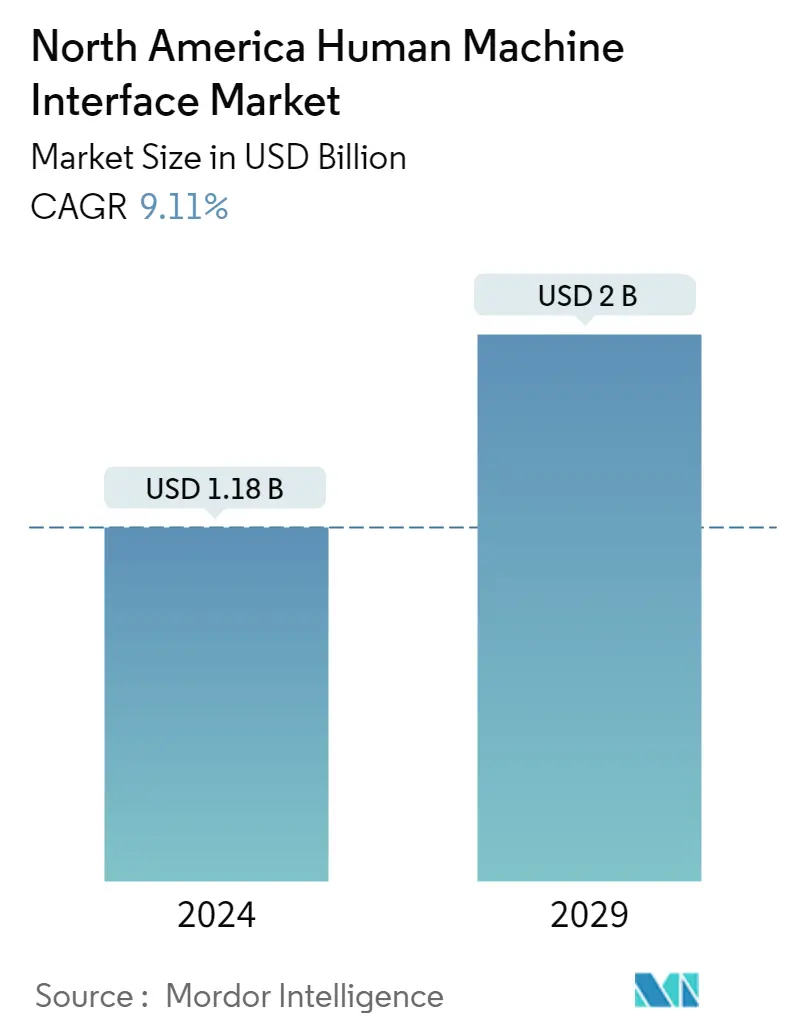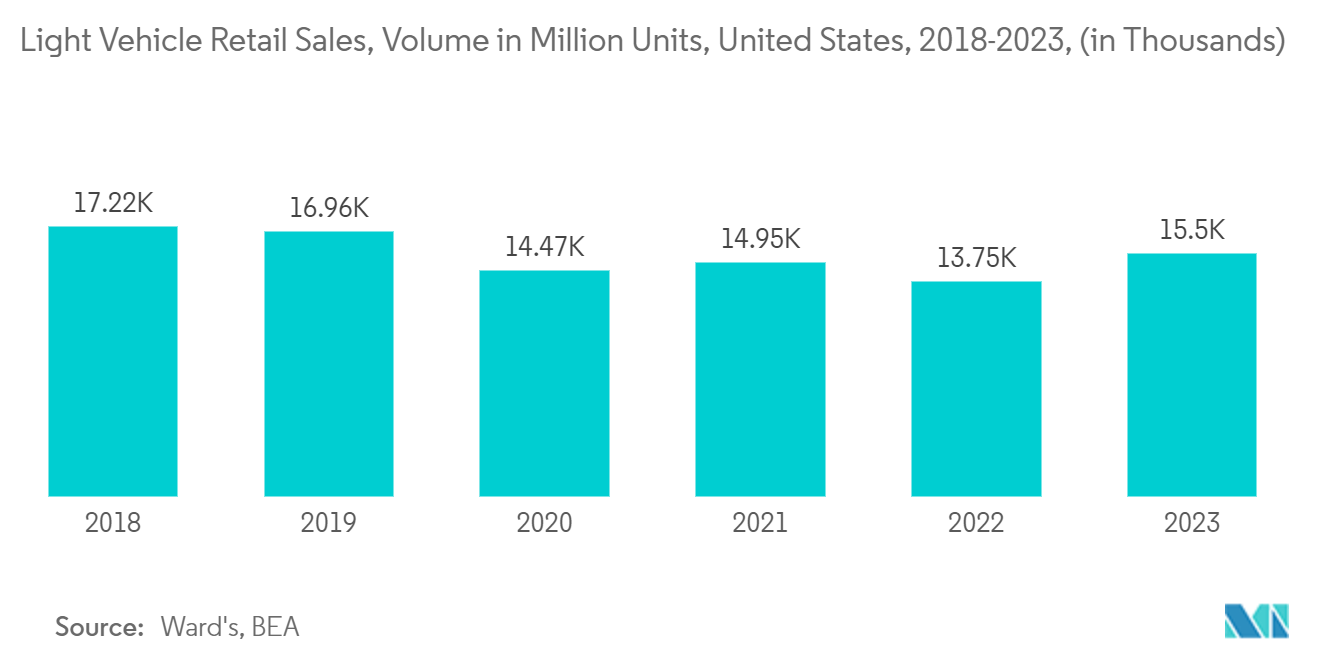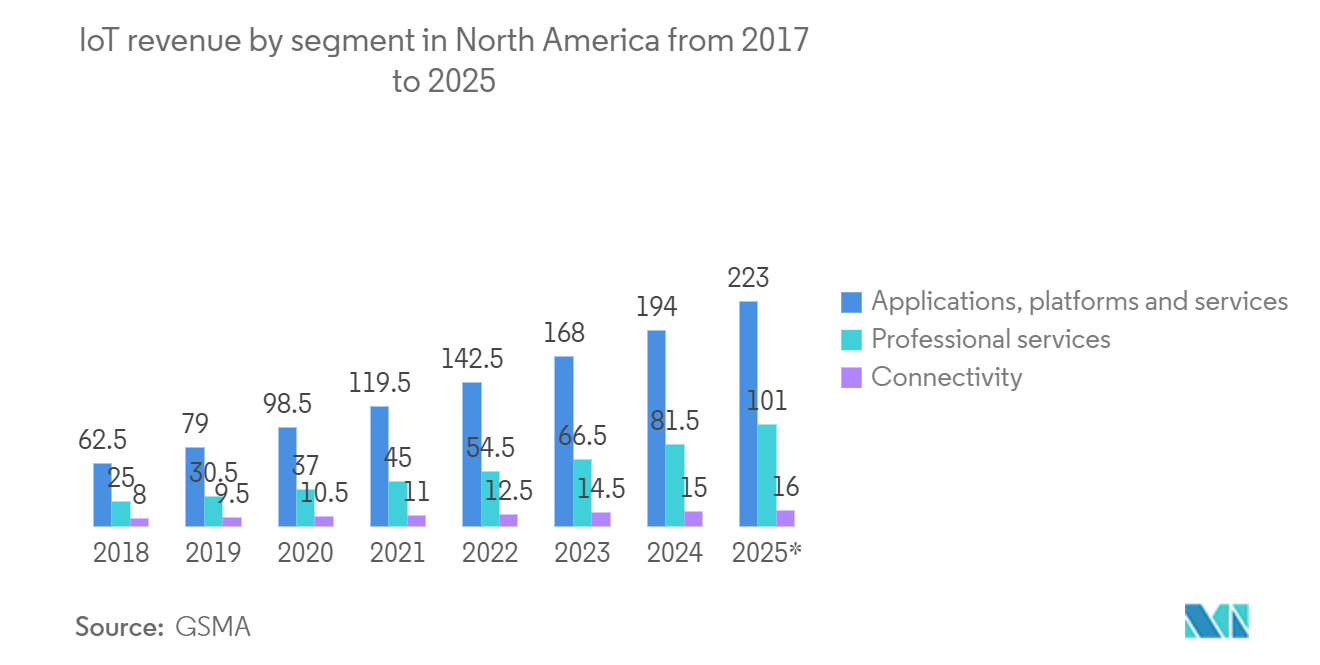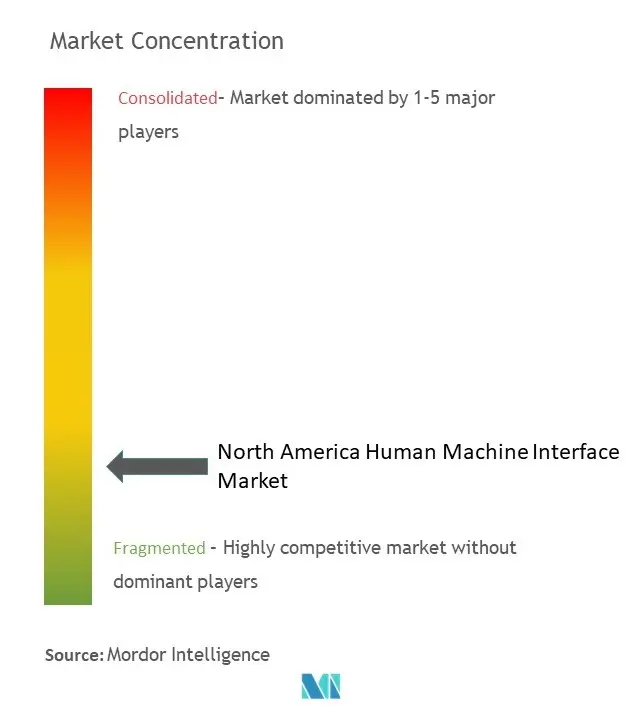North America Human Machine Interface Market Size

| Study Period | 2019 - 2029 |
| Base Year For Estimation | 2023 |
| Market Size (2024) | USD 1.18 Billion |
| Market Size (2029) | USD 2 Billion |
| CAGR (2024 - 2029) | 9.11 % |
| Market Concentration | Low |
Major Players
*Disclaimer: Major Players sorted in no particular order |
North America Human Machine Interface Market Analysis
The North America Human Machine Interface Market size is estimated at USD 1.18 billion in 2024, and is expected to reach USD 2 billion by 2029, growing at a CAGR of 9.11% during the forecast period (2024-2029).
The key factor contributing to the growth of the market is the increasing adoption of industrial automation across the manufacturing sector. Moreover, other factors, such as the growing demand for smart automation solutions, advancements in the Industrial Internet of Things (IIoT) technology, and the surging need to monitor and increase the efficiency of manufacturing units, are also significantly contributing to the growth of the market.
- The manufacturers in the region are considered to be one of the most fervent adopters of Industry 4.0. The operational benefits of advanced technologies, such as IoT and big data, have made North American manufacturers more inclined to integrate IoT technologies into their processes. Moreover, the growing number of small and medium enterprises (SMEs) in the region and increasing digitization in manufacturing by various large organizations have also propelled the growth of the IoT in the regional manufacturing market. Therefore, the increasing efforts of the companies in the region to move towards Industry 4.0 operations are expected to propel the demand in the region.
- Demand for automating the industrial process has seen a steady increase. The market has seen significant growth in automation industries, facilitating the demand for Human Machine Interface (HMI) products. HMI helps increase the efficiency of the user and secures the data. The initial high cost associated with deploying such products acts as a challenge to the market's growth. Besides, HMIs are not limited to manufacturing enterprises. It is increasingly used by various enterprises operating in industry verticals like energy, healthcare, and defense.
- Human-machine interfaces communicate with Programmable Logic Controllers (PLCs) and input/output sensors for obtaining and displaying information for the users to view. The HMI screens can be used for tracking and monitoring or performing other operations, such as controlling the machines.
- Previously, operators were required to walk the floor constantly to review mechanical progress and record it on a whiteboard or a paper for future reference. By allowing PLCs to transmit real-time information straight on an HMI display, the HMI technology significantly eliminates the need for this manual and outdated practice, reducing several problems caused by lack of information or human error.
- Further, HMIs optimize an industrial process as it allows digitization and centralization of data for a viewer. By leveraging HMI, operators can see crucial information and data displayed in charts, graphs, or digital dashboards. Further, it allows them to view and manage alarms and connect with MES and SCADA systems, all through one console.
North America Human Machine Interface Market Trends
Automotive is Expected to Hold Significant Share
- The automotive industry has been witnessing significant advancements over the past several years. Increased emphasis is being given to advanced driver assistance systems (ADAS). Moreover, customers in this segment increasingly demand feature-loaded vehicles that give them more control over the vehicle.
- Additionally, infotainment systems have also witnessed drastic changes over time, with automotive companies increasingly providing large touch panels in vehicles, primarily cars, enabling the users to interact with the vehicle more efficiently. Companies such as Tesla, General Motors, and Ford Motor Company increasingly provide these features in their vehicles to attract more customers.
- Moreover, various automotive companies, such as Tesla, are continuously developing autonomous vehicles that can drive by themselves while keeping the passengers informed about the routes, traffic conditions, speed, and other aspects. Herein, HMI technologies play a vital role in providing real-time information to passengers.
- Modern vehicles already employ a variety of interaction methods that were inconceivable only a few years ago. Drivers use a hands-free HMI system to interact with their vehicle, connected systems within it, and the environment surrounding it. Such advancements in automotive designs promote the adoption of HMIs in the automotive segment.
- For instance, in November 2022, Ford Motor Company announced the launch of a new ultra-high specification ranger platinum pickup with exterior detailing and finishes that enhance the Ranger’s characterful design. Also, Ranger Platinum is available in five-seat, double cab specification and is powered by Ford’s 3.0-liter V6 turbodiesel engine.
- Also, in recent years, the integration of smartphones with vehicle HMIs has gained prominence in North America. Apple CarPlay and Android Auto allow seamless integration of smartphone apps with the car's display, providing familiar interfaces to drivers. This minimizes the learning curve for using in-car systems and promotes safer usage of smartphone features.
- Furthermore, voice recognition systems, powered by natural language processing, enable drivers to interact with the vehicle using spoken commands. These systems have evolved to understand context, allowing for more conversational interactions. Drivers can adjust settings, make calls, and send messages, all while keeping their hands on the wheel and eyes on the road.

United States To Hold The Largest Market Share
- The North American region is expected to move towards adopting IoT in its operations quickly. This is majorly contributed by countries such as the US. According to the GSMA, the urgency to deploy IoT projects is significantly more substantial in the US than in other countries.
- The US is considered to be an early adopter of various technologies. Many heavy industry companies are accelerating their digital transformation journeys due to recent global events, particularly in engineering, mining, oil & gas, and manufacturing fields.
- Moreover, OnLogic, a global industrial computer hardware manufacturer and IoT solution provider, announced its plan to build a new 125,000-square-foot global headquarters in South Burlington, Vermont. The new facility accommodates the growing production needs of the company while also providing its local team with an environment fostering continued innovation. Moreover, the USD 50 million project aims to house manufacturing, testing, warehousing facilities, and all other business operations to support the production of the company's small form factor, industrial computers.
- Human Machines Interfaces also provide manufacturers with asset management capabilities. Accuracy in real-time data and reports allows managers to be more efficient and make just the right maintenance plans for businesses. As such, industries are increasingly adopting HMIs to enhance their asset management capabilities.

North America Human Machine Interface Industry Overview
The North American human machine interface (HMI) market is characterized by fragmentation, as numerous companies offer a wide range of hardware, software, and related services. These companies actively pursue strategic partnerships, collaborations, product development, and geographic expansion to expand their customer base and enhance their market share. The market is highly competitive, with several prominent players, including ABB Ltd, Rockwell Automation Inc., Honeywell International Inc., Siemens AG, and Schneider Electric SE, among others.
In November 2022, Mitsubishi Electric introduced two new Graphic Operation Terminals (GOTs) as part of its ongoing commitment to innovation. These newly unveiled GOTs represent the latest additions to the GOT2000 Series Wide Model lineup. They have been specifically designed to cater to the needs of customers who require a larger screen for better data visualization in various contexts, including factory, process, utility, and other automation applications.
North America Human Machine Interface Market Leaders
-
ABB
-
Schneider Electric Ltd
-
Siemens
-
Rockwell Automation, Inc.
-
Honeywell International Inc.
*Disclaimer: Major Players sorted in no particular order

North America Human Machine Interface Market News
- April 2023: Beijer Electronics announced the acquisition of Smart HMI, along with its cutting-edge technical platform, WebIQ. This strategic move marks a pivotal step in Beijer Electronics' journey, as it reinforces the company's commitment to expanding its digitalization and visualization portfolio.
- October 2022: Emerson Electric Co. executed a noteworthy acquisition, securing Progea Group, a prominent provider of HMI, SCADA, and PLC systems. With this acquisition, Emerson Electric Co. has significantly bolstered its capabilities, enabling its clients to access a broader range of resources and expertise. Furthermore, this strategic move positions Emerson Electric Co. to offer comprehensive hardware and software solutions to its valued clientele.
North America Human Machine InterfaceMarket Report - Table of Contents
1. INTRODUCTION
- 1.1 Study Assumptions and Market Definition
- 1.2 Scope of the Study
2. RESEARCH METHODOLOGY
3. EXECUTIVE SUMMARY
4. MARKET DYNAMICS
- 4.1 Market Overview
-
4.2 Market Drivers
- 4.2.1 Adoption of IoT and Shift towards industry 4.0
- 4.2.2 Benefits of Efficiency and Data Security
-
4.3 Market Restraints
- 4.3.1 High Investment Cost
- 4.4 Value Chain / Supply Chain Analysis
-
4.5 Porter's Five Forces Analysis
- 4.5.1 Threat of New Entrants
- 4.5.2 Bargaining Power of Buyers
- 4.5.3 Bargaining Power of Suppliers
- 4.5.4 Threat of Substitute Products
- 4.5.5 Intensity of Competitive Rivalry
5. MARKET SEGMENTATION
-
5.1 Type of Offering
- 5.1.1 Hardware
- 5.1.2 Software
- 5.1.3 Services
-
5.2 End-User Industry
- 5.2.1 Automotive
- 5.2.2 Food and Beverage
- 5.2.3 Packaging
- 5.2.4 Pharmaceutical
- 5.2.5 Oil and Gas
- 5.2.6 Metal and Mining
- 5.2.7 Other End-Users
-
5.3 Country
- 5.3.1 North America
- 5.3.1.1 United States
- 5.3.1.2 Canada
6. COMPETITIVE LANDSCAPE
-
6.1 Company Profiles
- 6.1.1 ABB
- 6.1.2 Siemens
- 6.1.3 Schneider Electric Ltd
- 6.1.4 GE Ltd
- 6.1.5 Rockwell Automation, Inc.
- 6.1.6 Honeywell International Inc.
- 6.1.7 Panasonic Corporation
- 6.1.8 Mitsubishi Electric Corporation
- 6.1.9 Omron Ltd
- 6.1.10 Eaton Corporation
- 6.1.11 Beijer Electronics, Inc.
- 6.1.12 Yokogawa Electric Corporation
- *List Not Exhaustive
7. INVESTMENT ANALYSIS
8. FUTURE OF THE MARKET
** Subject To AvailablityNorth America Human Machine Interface Industry Segmentation
A human-machine interface (HMI) is used to optimize a process by centralizing and digitizing for the user, where the operators can see important pieces of information in different forms of graphs, chatbots, or digital assistance. The adoption of automation in various end-user industries, like as food and beverages, packaging, etc., to increase operational efficiencies is a significant trend catalyzing the expansion of the human-machine interface market. The increasing number of industrial applications and automation in the United States is expected to propel the utilization of human-machine interfaces in the country, helping the industry grow.
The North America human machine interface market is segmented by type of offering (hardware, software, and services), end-user industry (automotive, food and beverage, packaging, pharmaceutical, oil and gas, metal and mining, and other end-users), and country (United States, Canada).
The market sizes and forecasts are provided in terms of value (USD) for all the above segments.
| Type of Offering | Hardware | |
| Software | ||
| Services | ||
| End-User Industry | Automotive | |
| Food and Beverage | ||
| Packaging | ||
| Pharmaceutical | ||
| Oil and Gas | ||
| Metal and Mining | ||
| Other End-Users | ||
| Country | North America | United States |
| Canada |
North America Human Machine InterfaceMarket Research FAQs
How big is the North America Human Machine Interface Market?
The North America Human Machine Interface Market size is expected to reach USD 1.18 billion in 2024 and grow at a CAGR of 9.11% to reach USD 2 billion by 2029.
What is the current North America Human Machine Interface Market size?
In 2024, the North America Human Machine Interface Market size is expected to reach USD 1.18 billion.
Who are the key players in North America Human Machine Interface Market?
ABB, Schneider Electric Ltd, Siemens, Rockwell Automation, Inc. and Honeywell International Inc. are the major companies operating in the North America Human Machine Interface Market.
What years does this North America Human Machine Interface Market cover, and what was the market size in 2023?
In 2023, the North America Human Machine Interface Market size was estimated at USD 1.07 billion. The report covers the North America Human Machine Interface Market historical market size for years: 2019, 2020, 2021, 2022 and 2023. The report also forecasts the North America Human Machine Interface Market size for years: 2024, 2025, 2026, 2027, 2028 and 2029.
North America Human Machine InterfaceIndustry Report
Statistics for the 2024 North America Human Machine Interface market share, size and revenue growth rate, created by Mordor Intelligence™ Industry Reports. North America Human Machine Interface analysis includes a market forecast outlook to for 2024 to 2029 and historical overview. Get a sample of this industry analysis as a free report PDF download.



